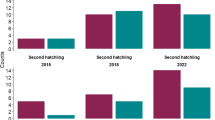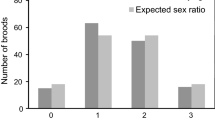Abstract
Bias in sex ratios at hatching and sex specific post hatching mortality in size dimorphic species has been frequently detected, and is usually skewed towards the production and survival of the smaller sex. Since common terns Sterna hirundo show a limited sexual size dimorphism, with males being only about 1–6% larger than females in a few measurements, we would expect to find small or no differences in production and survival of sons and daughters. To test this prediction, we carried out a 2-year observational study on sex ratio variation in common terns at hatching and on sex specific post hatching mortality. Sons and daughters hatched from eggs of similar volume. Post hatching mortality was heavily influenced by hatching sequence. In addition, we detected a sex specific mortality bias towards sons. Overall, hatching sex ratio and sex specific mortality resulted in fledging sex ratios 8% biased towards females. Thus, other reasons than body size may be influencing the costs of rearing sons. Son mortality was not homogeneous between brood sizes, but greater for two-chick broods. Since adults rearing two-chick broods were younger, lighter and bred consistently later than those rearing three-chick broods, it is suggested that lower capacity of two-chick brood parents adversely affected offspring survival of sons. Though not significantly, two-chick broods tended to be female biased at hatching, perhaps to counteract the greater male-biased nestling mortality. Thus, population bias in secondary sex ratio is not limited to strongly size dimorphic species, but species with a slight sexual size dimorphism can also show sex ratio bias through a combination of differential production and mortality of sons and daughters.

Similar content being viewed by others
References
Anderson DJ, Reeve J, Gomez JEM, Weathers WW, Huston S, Cunningham HV, Bird DM (1993) Sexual size dimorphism and food requirements of nestling birds. Can J Zool 71:2541–2545
Anderson DJ, Reeve J, Bird DM (1997) Sexually dimorphic eggs, nestling growth and sibling competition in American kestrels Falco sparvarius. Funct Ecol 11:331–335
Becker PH (1998) Langzeittrends des Bruterfolgs der Flussseeschwalbe und seiner Einflußgrößen im Wattenmeer. Vogelwelt 119:223–234
Becker PH, Finck P (1985) Witterung und Ernährungssituation als entscheidende Faktoren des Bruterfolgs der Fluβseeschwalbe Sterna hirundo. J Ornithol 126:393–404
Becker PH, Wendeln H (1997) A new application for transponders in population ecology of the Common Tern. Condor 99:534–538
Becker PH, Wink M (2003) Influences of sex, sex composition of brood and hatching order on mass growth in Common Terns Sterna hirundo. Behav Ecol Sociobiol 54:136–146
Becker PH, Wendeln H, González-Solís J (2001) Population dynamics, recruitment, individual quality and reproductive strategies in common terns Sterna hirundo marked with transponders. Ardea 89 (special issue):241–252
Bednarz JC, Hayden TJ (1991) Skewed brood sex ratio and sex-biased hatching sequence in Harris’s hawks. Am Nat 137:116–132
Bollinger PB (1994) Relative effects of hatching order, egg-size variation, and parental quality on chick survival in common terns. Auk 111:263–273
Bollinger PT, Bollinger EK, Malecki RA (1990) Tests of three hypotheses of hatching asynchrony in the Common Tern. Auk 107:696–706
Bortolotti GR (1986) Influence of sibling competition on nestling sex ratios of sexually dimorphic birds. Am Nat 127:495–507
Bradbury RB, Blakey JK (1998) Diet, maternal condition, and offspring sex ratio in the zebra finch, Poephila guttata. Proc R Soc Lond B 265:895–899
Brommer JE, Karell P, Pihlaja T, Painter JN, Primmer CR, Pietiäinen H (2003) Ural owl sex allocation and parental investment under poor food conditions. Oecologia 137:140–147
Clutton-Brock TH, Albon SD, Guinness FE (1985) Parental investment and sex differences in juvenile mortality in birds and mammals. Nature 313:131–133
Cockburn A, Legge S, Double MC (2002) Sex ratios in birds and mammals: can the hypotheses be disentangled?. In: Hardy ICW (ed) Sex ratios; concepts and research methods. Cambridge University Press, Cambridge, pp 266–286
Cordero P, Griffith SC, Aparicio JM, Parkin DT (2000) Sexual dimorphism in house sparrow eggs. Behav Ecol Sociobiol 48:353–357
Coulson JC, Porter JM (1985) Reproductive success of the Kittiwake Rissa tridactyla: the role of clutch size, chick growth rates and parental quality. Ibis 127:450–466
Coulter MC (1986) Assortative mating and sexual dimorphism in the Common Tern. Wilson Bull 98:93–100
Craik JCA (1999) Sexual dimorphism of Common Terns Sterna hirundo and Arctic Terns S.paradisea. Ringing Migration 19:311–312
Daunt F, Monaghan P, Wanless S, Harris MP, Griffiths R (2001) Sons and daughters: age-specific differences in parental rearing capacities. Funct Ecol 15:211–216
Dijkstra C, Daan S, Pen I (1998) Fledgling sex ratios in relation to brood size in size-dimorphic altricial birds. Behav Ecol 9:287–296
Ewen JG, Cassey P, Moller AP (2004) Facultative primary sex ratio variation: a lack of evidence in birds? Proc R Soc Biol Sci B 271:1277–1282
Fisher RA (1930) The genetical theory of natural selection. Clarendon, Oxford
Fletcher KL, Hamer KC (2004) Offspring sex ratio in the Common Tern Sterna hirundo, a species with negligible sexual size dimorphism. Ibis 146:454–460
Folstad I, Karter AJ (1992) Parasites, bright males, and the immunocompetence handicap. Am Nat 139:603–622
González-Solís J, Becker PH, Jover L, Ruiz X (1999a) Intraindividual seasonal decline of egg-volume in Common Tern Sterna hirundo. Acta Ornithol 34:185–190
González-Solís J, Becker PH, Wendeln H (1999b) Mate fidelity and arrival asynchrony in common terns Sterna hirundo. Anim Behav 58:1123–1129
Griffiths R (1992) Sex-biased mortality in the Lesser Black-backed Gull Larus fuscus during the nestling stage. Ibis 134:237–244
Hipkiss T, Hörnfeldt B, Eklund U, Berlin S (2002) Year-dependent sex-biased mortality in supplementary-fed Tengmalm’s owl nestlings. J Anim Ecol 71:693–699
Kahn NW, John JS, Quinn TW (1998) Chromosome-specific intron size differences in the avian CHD gene provide a efficient method for sex identification in birds. Auk 115:1974–1078
Kalmbach E, Nager RG, Griffiths R, Furness RW (2001) Increased reproductive effort results in male-biased offspring sex ratio: an experimental study in a species with reversed sexual size dimorphism. Proc R Soc Lond B 268:2175–2179
Kilner R (1998) Primary and secondary sex ratio manipulation by zebra finches. Anim Behav 56:155–164
Kilpi M, Hillström L, Lindström K (1996) Egg-size variation and reproductive success in the Herring Gull Larus argentatus: adaptative or constrained size of the last egg? Ibis 138:212–217
Komdeur J, Daan S, Tinbergen J, Mateman C (1997) Extreme adaptive modification in sex ratio of the Seychelles warbler’s eggs. Nature 385:522–525
Krackow S (2002) Why parental sex ratio manipulation is rare in higher vertebrates. Ethology 108:1041–1056
Krackow S, Tkadlec E (2001) Analysis of brood sex ratios: implications of offspring clustering. Behav Ecol Sociobiol 50:293–301
Krijgsveld KL, Dijkstra C, Visser GH, Daan S (1998) Energy requirements for growth in relation to sexual size dimorphism in marsh harrier Circus aeruginosus nestlings. Physiol Zool 71:693–702
Lack D (1954) The natural regulation of animal numbers. Oxford University Press, London
Langham NPE (1972) Chick survival in Terns, Sterna spp. with particular reference to the Common Tern. J Anim Ecol 41:385–395
Lessells CM, Mateman AC, Visser J (1996) Great Tit hatching sex ratios. J Avian Biol 27:135–142
Morris RD, Woulfe M, Wichert GD (1991) Hatching asynchrony, chick care, and adoption in the common tern: can disadvantaged chicks win? Can J Zool 69:661–668
Nager RG, Monaghan P, Griffiths R, Houston DC, Dawson R (1999) Experimental demonstration that offspring sex ratio varies with maternal condition. Proc Natl Acad Sci USA 96:570–573
Nager RG, Monaghan P, Houston DC, Genovart M (2000) Parental condition, brood sex ratio and differential young survival: an experimental study in gulls (Larus fuscus). Behav Ecol Sociobiol 48:452–457
Parsons J (1975) Asynchronous hatching and chick mortality in the Herring Gull Larus argentatus. Ibis 117:517–520
Phillips RA, Furness RW (1998) Repeatability of breeding parameters in Arctic Skuas. J Avian Biol 29:190–196
Pierotti R, Bellrose CA (1986) Proximate and ultimate causation of egg size and the “third-chick disadvantage” in the Western Gull. Auk 103:401–407
Pike TW, Petrie M (2003) Potential mechanisms of avian sex manipulation. Biol Rev 78:553–574
Reid WV (1987) Constraints on clutch size in the glaucous-winged gull. Stud Avian Biol 10:8–25
Ryder JP, Termaat BM (1987) Secondary sex ratios and egg sequence in herring gulls. Auk 104:526–528
SAS Institute (1999) SAS/STAT user’s guide. Cary, NC
Sayce JR, Hunt GL Jr (1987) Sex ratios of prefledging western gulls. Auk 104:33–37
Sheldon BC, Merila J, Lindgren G, Ellegren H (1998) Gender and environmental sensitivity in nestling collared flycatchers. Ecology 79:1939–1948
Slagsvold T, Sandvik J, Rofstad G, Lorentsen Ö, Husby M (1984) On the adaptative value of intraclutch egg-size variation in birds. Auk 101:685–697
Sydeman WJ, Eddy JO (1995) Repeatability in laying date and its relationship to individual quality for Common Murres. Condor 97:1048–1052
Szczys P, Nisbet ICT, Hatch JJ, Kesseli R (2001) Sex ratio bias at hatching and fledging in the roseate tern. Condor 103:385–389
Torres R, Drummond H (1997) Female-biased mortality in nestlings of a bird with size dimorphism. J Anim Ecol 66:859–865
Torres R, Drummond H (1999) Variably male-biased sex ratio in a marine bird with females larger than males. Oecologia 118:16–22
Trivers RL, Willard DE (1973) Natural selection of parental ability to vary the sex ratio of offspring. Science 179:90–92
Weatherhead PJ, Teather KL (1991) Are skewed fledgling sex ratios in sexually dimorphic birds adaptive? Am Nat 138:1159–1172
Weimerskirch H, Barbraud C, Lys P (2000) Sex differences in parental investment and chick growth in Wandering Albatrosses: fitness consequences. Ecology 81:309–318
Wendeln H, Becker PH (1996) Body mass change in breeding Common Terns Sterna hirundo. Bird Study 43:85–95
Wendeln H, Becker PH (1999) Effects of parental quality and effort on the reproduction of Common Terns (Sterna hirundo). J Anim Ecol 68:205–214
Wendeln H, Becker PH, Wagener M (1997) Beziehungen zwischen Körpermasse und Körpergröβe bei Paarpartnern der Fluβseeschwalbe (Sterna hirundo). Vogelwarte 39:141–148
Wiebe KL, Bortolotti GR (1992) Facultative sex ratio manipulation in American kestrels. Behav Ecol Sociobiol 30:379–383
Acknowledgements
This study was supported by the Deutsche Forschungsgemeinschaft (Be 916/5). During fieldwork and writing J.G-S. was supported by a post-doctoral grant from Ministerio de Educación y Ciencia of Spain, a ‘Marie Curie’ grant of the European Union, a Postdoctoral grant of the Generalitat de Catalunya, and contract of the Program ‘Ramón y Cajal’ of the Ministerio de Ciencia y Tecnología of Spain co-funded by Fondos FEDER. We are grateful to TROVAN for offering transponders. We thank I. Kolaschnik, E. Fredrich, M. Wagener, A. Wilms, B. Bloechinger for their help in the field, E. Sokolov for his help sexing dead chicks, H. Sauer-Gürth for technical assistance in molecular sex determination and L. Jover for performing some statistical analyses. Comments of K. Lessels, I. Nisbet, P. Szczys, M.T. Murphy, K. Wiebe and A.E. Powell and anonymous referees on earlier versions greatly improved the manuscript. J.G-S. does not thank Kimberly Smith, the editor of Auk, for retaining an earlier version of this paper for more than two years (from December 2001 to April 2004), and finally rejecting it after losing the referee’s comments before the authors could see them. The investigations were performed under licences of the Niedersächsisches Landesverwaltungsamt, Hanover, and of the Bezirksregierung Weser–Ems, Oldenburg (Tierschutzangelegenheiten; Nationalparkverwaltung).
Author information
Authors and Affiliations
Corresponding author
Additional information
Communicated by F. Bairlein
Rights and permissions
About this article
Cite this article
González-Solís, J., Becker, P.H., Wendeln, H. et al. Hatching sex ratio and sex specific chick mortality in common terns Sterna hirundo. J Ornithol 146, 235–243 (2005). https://doi.org/10.1007/s10336-005-0084-7
Received:
Revised:
Accepted:
Published:
Issue Date:
DOI: https://doi.org/10.1007/s10336-005-0084-7




